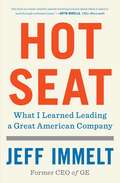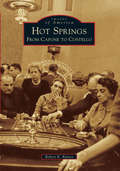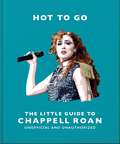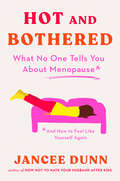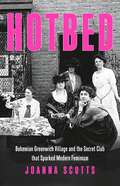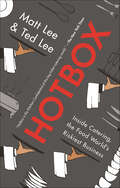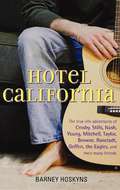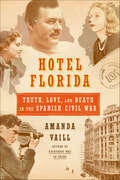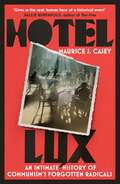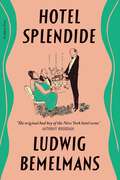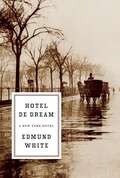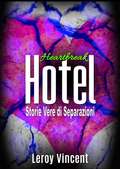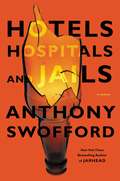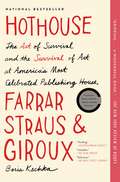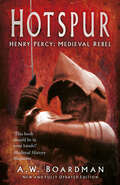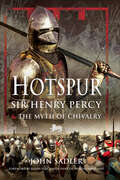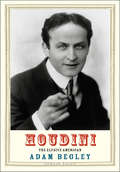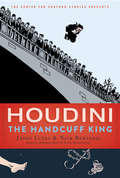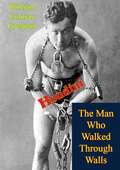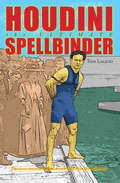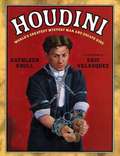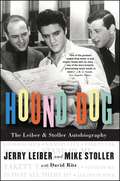- Table View
- List View
Hot Seat: What I Learned Leading a Great American Company
by Jeff ImmeltA memoir of successful leadership in times of crisis: the former CEO of General Electric, named one of the &“World&’s Best CEOs&” three times by Barron&’s, shares the hard-won lessons he learned from his experience leading GE immediately after 9/11, through the economic devastation of the 2008–09 financial crisis, and into an increasingly globalized world.In September 2001, Jeff Immelt replaced the most famous CEO in history, Jack Welch, at the helm of General Electric. Less than a week into his tenure, the 9/11 terrorist attacks shook the nation, and the company, to its core. GE was connected to nearly every part of the tragedy—GE-financed planes powered by GE-manufactured engines had just destroyed real estate that was insured by GE-issued policies. Facing an unprecedented situation, Immelt knew his response would set the tone for businesses everywhere that looked to GE—one of America&’s biggest and most-heralded corporations—for direction. No pressure. Over the next sixteen years, Immelt would lead GE through many more dire moments, from the 2008–09 Global Financial Crisis to the 2011 meltdown of Fukushima&’s nuclear reactors, which were designed by GE. But Immelt&’s biggest challenge was inherited: Welch had handed over a company that had great people, but was short on innovation. Immelt set out to change GE&’s focus by making it more global, more rooted in technology, and more diverse. But the stock market rarely rewarded his efforts, and GE struggled. In Hot Seat, Immelt offers a rigorous, candid interrogation of himself and his tenure, detailing for the first time his proudest moments and his biggest mistakes. The most crucial component of leadership, he writes, is the willingness to make decisions. But knowing what to do is a thousand times easier than knowing when to do it. Perseverance, combined with clear communication, can ensure progress, if not perfection, he says. That won&’t protect any CEO from second-guessing, but Immelt explains how he&’s pushed through even the most withering criticism: by staying focused on his team and the goals they tried to achieve. As the business world continues to be rocked by stunning economic upheaval, Hot Seat is an urgently needed, and unusually raw, source of authoritative guidance for decisive leadership in uncertain times.
Hot Springs: From Capone to Costello (Images of America)
by Robert K. RainesIn the late 1800s, Hot Springs, Arkansas, was a small town with a big attraction: hot thermal water. The federal government took possession of the downtown-area springs, and bathhouse row was born, along with the first property that would be considered a national park. Following not too far behind were great entrepreneurs who brought in gambling and prostitution to go with the area's leading industry: moonshining. By the time the 20th century rolled in, Hot Springs was booming with tourists and became America's first resort. In the early 1930s, former New York gangster Owen Madden took up residence in the spa city, and things became very organized. Gangland luminaries from Al Capone to Frank Costello made regular pilgrimages over the next few decades to what was referred to as "the loose buckle in the Bible Belt."
Hot To Go: The Little Guide to Chappell Roan
by OHChappell Roan - your favourite artist's favourite artist - is hot-to-go right now following her multiple Grammy Award nominations at next year's prestigious ceremony. With more than three billion streams on Spotify (after just one album!), Chappell has come a long way from her religious, super-conservative upbringing in Willard, Missouri. But she's no overnight sensation. For ten years now, singer-songwriter Kayleigh Rose Amstutz has been hard at work mastering her musical craft and sculpting her drag queen alter-ego into the magnificently-manicured masterpiece we marvel at today. Now, is Chappell's time to shine, and we all can't wait.Witty, wise and wickedly refreshing, this tiny tome celebrates all that is fantastic about Chappell Roan, as told by the Midwest Princess herself through 175 of her most iconic interview quotes, plus a sprinkling of glittery trivia too, obvs. Only one question remains: Are you bitches ready for it?SAMPLE TEXT"I'm very turned off by celebrity. Some girls have been in this so long that they're used to that, but I'm not that girl. I'm not gonna be a sweetie pie to a man who's telling me to shut the fuck up. If you're an asshole, I'm gonna be like: 'Yo, fuck off.' You don't get to talk to me like that. I'm confrontational."Chappell Roan"I feel like I'm just being my 10-year-old self. This whole project is to honour my 10-year-old self. My whole persona is just me trying to honour that version of myself that I was never allowed to be."Chappell RoanWith more than 42 million monthly listeners on Spotify and more than three billion total streams on the platform to date, Chappell Roan is now one of the most streamed female artists - ever! Her most popular song on the platform is "Good Luck, Babe!" with more than 950 million streams. It'll be well over a billion by the time you read this.Chappell's debut album earned her her first Grammy Award nominations at the 67th annual ceremony in 2025, making her one of 12 artists in history to have earned Grammy nominations in all of the "Big Four" categories for their debut studio album, including album of the year, record of the year, song of the year and best new artist.
Hot To Go: The Little Guide to Chappell Roan
by OHChappell Roan - your favourite artist's favourite artist - is hot-to-go right now following her multiple Grammy Award nominations at next year's prestigious ceremony. With more than three billion streams on Spotify (after just one album!), Chappell has come a long way from her religious, super-conservative upbringing in Willard, Missouri. But she's no overnight sensation. For ten years now, singer-songwriter Kayleigh Rose Amstutz has been hard at work mastering her musical craft and sculpting her drag queen alter-ego into the magnificently-manicured masterpiece we marvel at today. Now, is Chappell's time to shine, and we all can't wait.Witty, wise and wickedly refreshing, this tiny tome celebrates all that is fantastic about Chappell Roan, as told by the Midwest Princess herself through 175 of her most iconic interview quotes, plus a sprinkling of glittery trivia too, obvs. Only one question remains: Are you bitches ready for it?SAMPLE TEXT"I'm very turned off by celebrity. Some girls have been in this so long that they're used to that, but I'm not that girl. I'm not gonna be a sweetie pie to a man who's telling me to shut the fuck up. If you're an asshole, I'm gonna be like: 'Yo, fuck off.' You don't get to talk to me like that. I'm confrontational."Chappell Roan"I feel like I'm just being my 10-year-old self. This whole project is to honour my 10-year-old self. My whole persona is just me trying to honour that version of myself that I was never allowed to be."Chappell RoanWith more than 42 million monthly listeners on Spotify and more than three billion total streams on the platform to date, Chappell Roan is now one of the most streamed female artists - ever! Her most popular song on the platform is "Good Luck, Babe!" with more than 950 million streams. It'll be well over a billion by the time you read this.Chappell's debut album earned her her first Grammy Award nominations at the 67th annual ceremony in 2025, making her one of 12 artists in history to have earned Grammy nominations in all of the "Big Four" categories for their debut studio album, including album of the year, record of the year, song of the year and best new artist.
Hot and Bothered: What No One Tells You About Menopause and How to Feel Like Yourself Again
by Jancee Dunn&“Hot and Bothered removes the shame, disdain, and mystery that&’s surrounded menopause….An informative, entertaining and desperately needed book.&” —Jen Sincero, author of You Are a BadassWhen Jancee Dunn hit her mid-forties, she was bombarded by seemingly random symptoms: rampant insomnia, spring-loaded nerves, weirdly dry mouth, and Rio Grande-level periods. After going to multiple doctors who ran test after fruitless test, she was surprised to finally discover the culprit—perimenopause. For more than two decades, Jancee had been reporting on mental and physical health. So if she was unprepared for this, what about all the women who don&’t write about health for a living?Hot and Bothered is the book she wishes existed as she was scrambling for information: an empowering, research-based guide on how women can tackle this new stage of life. Menopause isn&’t a disease, but a natural, normal life transition. Why, then, are we still speaking in whispers about something that affects half the earth&’s population?Through in-depth interviews with renowned menopause experts and trusted authorities, Dunn peels back the layers on this still-mystifying topic with her trademark humor and unpacks the science on both hormonal and nonhormonal treatments. She provides actionable ways to improve sleep, sex, moods, mental clarity, and skin; details the latest treatments for hot flashes; and explores the best practices to stop &“peezing&” (that would be peeing when you sneeze, thanks to your new urinary issues). Dunn&’s clear, easy-to-follow advice will help you reclaim yourself—and fully embrace life&’s next chapter.
Hotbed: Bohemian Greenwich Village and the Secret Club that Sparked Modern Feminism
by Joanna ScuttsThe dazzling story of the Greenwich Village feminists who blazed the trail for the movement&’s most radical ideasOn a Saturday in New York City in 1912, around the wooden tables of a popular Greenwich Village restaurant, a group of women gathered, all of them convinced that they were going to change the world.It was the first meeting of &“Heterodoxy,&” a secret social club. Its members were passionate advocates of free love, equal marriage, and easier divorce. They were socialites and socialists; reformers and revolutionaries; artists, writers, and scientists. Their club, at the heart of America&’s bohemia, was a springboard for parties, performances, and radical politics. But it was the women&’s extraordinary friendships that made their unconventional lives possible, as they supported each other in pushing for a better world.Hotbed is the never-before-told story of the bold women whose audacious ideas and unruly acts transformed a feminist agenda into a modern way of life.
Hotbox: Inside Catering, the Food World's Riskiest Business
by Matt Lee Ted LeeJames Beard Award–winning journalists expose food industry secrets in “the Kitchen Confidential of the big-ticket catering world” (New York Times).Hotbox reveals the real-life drama behind cavernous event spaces and soaring white tents, where cooking conditions have more in common with a mobile army hospital than a restaurant. Award-winning food writers the Lee brothers steeped themselves in the catering business for four years, learning the culture from the inside out. It’s a realm where you find eccentric characters, working in extreme conditions, who must produce magical events and instantly adapt when, for instance, the host’s toast runs a half-hour too long, a hail storm erupts, or a rolling rack of hundreds of ice cream desserts goes wheels-up.Whether they’re dashing through black-tie fundraisers or celebrity-spotting at a Hamptons cookout, the Lee brothers guide you on a romp from the inner circle—the elite team of chefs using little more than their wits and Sterno to turn out lamb shanks for eight hundred—to the outer reaches of the industries that facilitate the most dazzling galas. You’ll never attend a party—or entertain on your own—in the same way after reading this book.“Lively . . . [with] just the right combination of sophistication and self-deprecation [to] show us what really goes on behind the scenes.” —The Wall Street Journal“An absorbing, immersive, appetizing tale, written with sharp intelligence and style.” —Susan Orlean, New York Times–bestselling author of The Library Book“Brilliant, gleeful . . . full of tips and secrets.” —Bill Buford, national bestselling author of Heat“[A] captivating tell-all.” —Publishers Weekly
Hotel California: The True-Life Adventures Of Crosby, Stills, Nash, Young, Mitchell, Taylor, Brown, Ronstadt, Geffen, The Eagles, And Their Many Friends
by Barney HoskynsA look at the music scene in Los Angeles in the late 1960s and 1970s.
Hotel Florida: Truth, Love, and Death in the Spanish Civil War
by Amanda VaillA spellbinding story of love amid the devastation of the Spanish Civil WarMadrid, 1936. In a city blasted by a civil war that many fear will cross borders and engulf Europe—a conflict one writer will call "the decisive thing of the century"—six people meet and find their lives changed forever. Ernest Hemingway, his career stalled, his marriage sour, hopes that this war will give him fresh material and new romance; Martha Gellhorn, an ambitious novice journalist hungry for love and experience, thinks she will find both with Hemingway in Spain. Robert Capa and Gerda Taro, idealistic young photographers based in Paris, want to capture history in the making and are inventing modern photojournalism in the process. And Arturo Barea, chief of the Spanish government's foreign press office, and Ilsa Kulcsar, his Austrian deputy, are struggling to balance truth-telling with loyalty to their sometimes compromised cause—a struggle that places both of them in peril. Beginning with the cloak-and-dagger plot that precipitated the first gunshots of the war and moving forward month by month to the end of the conflict. Hotel Florida traces the tangled and disparate wartime destinies of these three couples against the backdrop of a critical moment in history: a moment that called forth both the best and the worst of those caught up in it. In this noir landscape of spies, soldiers, revolutionaries, and artists, the shadow line between truth and falsehood sometimes became faint indeed—your friend could be your enemy and honesty could get you (or someone else) killed. Years later, Hemingway would say, "It is very dangerous to write the truth in war, and the truth is very dangerous to come by." In Hotel Florida, from the raw material of unpublished letters and diaries, official documents, and recovered reels of film, the celebrated biographer Amanda Vaill has created a narrative of love and reinvention that is, finally, a story about truth: finding it, telling it, and living it—whatever the cost.*INCLUDES 16 PAGES OF BLACK-AND-WHITE PHOTOGRAPHS
Hotel Lux: An Intimate History of Communism's Forgotten Radicals
by Maurice CaseyThe extraordinary story of a group of forgotten radicals who found themselves drawn to communist Moscow&’s hotbed of international revolutionary activity: the Hotel Lux. Hotel Lux follows Irish radical May O&’Callaghan and her friends, three revolutionary families brought together by their vision for a communist future and their time spent in the Comintern&’s Moscow living quarters, the Hotel Lux. Historian Maurice Casey reveals the connections and disconnections of a group of forgotten communist activists whose lives collided in 1920s Moscow: a brilliant Irish translator, a maverick author, the rebel daughters of an East London Jewish family, and a family of determined German anti-fascists. The dramatic and interlocking histories of the O&’Flahertys, Cohens and Leonhards offer an intimate insight into the legacies of the Russian Revolution from its earliest idealism through to the brutal Stalinist purges and beyond. Hotel Lux uncovers a world of forgotten radicals who saw their hopes and dreams crash against reality yet retained their faith in a beautiful future for all. Culminating in a queer love story that saw the daughters of the Cohens and Leonhards create an enduring partnership even as their parents&’ political visions crumbled, this is a multi-generational rebel odyssey and a history of international communism, one which looks as much to the future as it does to the past.
Hotel Splendide
by Ludwig Bemelmans&“Truly a great book—unique, invaluable and unapproachable as the gold standard of the genre… Bemelmans got there first, more frequently, and better.&” —Anthony Bourdain Acerbic, colorful, and spirited stories from a bygone era: behind the scenes in a grand NY hotel, from the author of the Madeline books Picture David Sedaris writing Kitchen Confidential about the Ritz in New York in the 1920s, which had the style and charm of The Grand Budapest Hotel…In this charming and uproariously funny hotel memoir, Ludwig Bemelmans uncovers the fabulous world of the Hotel Splendide—the thinly disguised stand-in for the Ritz—a luxury New York hotel where he worked as a waiter in the 1920s. With equal parts affection and barbed wit, he uncovers the everyday chaos that reigns behind the smooth facades of the gilded dining room and banquet halls. In hilarious detail, Bemelmans sketches the hierarchy of hotel life and its strange and fascinating inhabitants: from the ruthlessly authoritarian maître d'hôtel Monsieur Victor to the kindly waiter Mespoulets to Frizl the homesick busboy. Illustrated with his own charming line drawings, Bemelmans' tales of a bygone era of extravagance are as charming as they are riotously entertaining. &“[Bemelmans] was the original bad boy of the NY hotel/restaurant subculture, a waiter, busboy, and restaurateur who &“told all&” in a series of funny and true (or very near true) autobiographical accounts of backstairs folly, excess, borderline criminality, and madness in the grande Hotel Splendide… If you like stories about old New York as I do, this classic will have you laughing out loud.&” –Anthony Bourdain
Hotel de Dream: A New York Novel
by Edmund WhiteIn a damp, old Sussex castle, American literary phenomenon Stephen Crane lies on his deathbed, wasting away from tuberculosis at the age of twenty-eight. The world-famous author has retreated to England with his wife, Cora, in part to avoid gossip about her ignominious past as the proprietress of an infamous Florida bordello, the Hotel de Dream. In the midst of gathering tragedy, Crane begins dictating what will surely be his final work: a strange and poignant novel of a boy prostitute in 1890s New York and the married man who ruins his own life to win his love.
Hotel di Crepacuore
by Leroy Vincent Alessandra SandrinHeartbreak Hotel: True Tales of Breakup Experiences è un libro pieno di storie vere di persone reali sulle esperienze di separazione. Questo libro è ottimo per chiunque sia alla ricerca di amore e ha avuto alcune delle date più folli. Le rotture sono reali e possono avere un effetto duraturo.
Hotel dos Corações Partidos: Histórias Reais de Rompimentos Amorosos
by Leroy VincentHotel dos Corações Partidos: Histórias Reais de Rompimentos Amorosos é um livro repleto de histórias reais de pessoas reais sobre experiências de términos de relacionamentos amorosos. Este livro é excelente para qualquer um que esteja procurando amor e tenha namoros disfuncionais. Términos são reais e podem ter um efeito duradouro.
Hotels, Hospitals, and Jails: A Memoir
by Anthony SwoffordThe publication of Jarhead launched a new career for Anthony Swofford, earning him accolades for its gritty and unexpected portraits of the soldiers who fought in the Gulf War. It spawned a Hollywood movie. It made Swofford famous and wealthy. It also nearly killed him. Now with the same unremitting intensity he brought to his first memoir, Swofford describes his search for identity, meaning, and a reconciliation with his dying father in the years after he returned from serving as a sniper in the Marines. Adjusting to life after war, he watched his older brother succumb to cancer and his first marriage crumble, leading him to pursue an excessive lifestyle in Manhattan that brought him to the brink of collapse. Consumed by drugs, drinking, expensive cars, and women, Swofford lost almost everything and everyone that mattered to him. When a son is in trouble he hopes to turn to his greatest source of wisdom and support: his father. But Swofford and his father didn't exactly have that kind of relationship. The key, he realized, was to confront the man-a philandering, once hard-drinking, now terminally ill Vietnam vet he had struggled hard to understand and even harder to love. The two stubborn, strong-willed war vets embarked on a series of RV trips that quickly became a kind of reckoning in which Swofford took his father to task for a lifetime of infidelities and abuse. For many years Swofford had considered combat the decisive test of a man's greatness. With the understanding that came from these trips and the fateful encounter that took him to a like-minded woman named Christa, Swofford began to understand that becoming a father himself might be the ultimate measure of his life. Elegantly weaving his family's past with his own present-nights of excess and sexual conquest, visits with injured war veterans, and a near-fatal car crash--Swofford casts a courageous, insistent eye on both his father and himself in order to make sense of what his military service meant, and to decide, after nearly ending it, what his life can and should become as a man, a veteran, and a father.
Hothouse: The Art of Survival and the Survival of Art at America's Most Celebrated Publishing House, Farrar, Straus, and Giroux
by Boris Kachka"Mad Men for the literary world." --Junot DíazFarrar, Straus and Giroux is arguably the most influential publishing house of the modern era. Home to an unrivaled twenty-five Nobel Prize winners and generation-defining authors like T. S. Eliot, Flannery O'Connor, Susan Sontag, Tom Wolfe, Joan Didion, Philip Roth, and Jonathan Franzen, it's a cultural institution whose importance approaches that of The New Yorker or The New York Times. But FSG is no ivory tower--the owner's wife called the office a "sexual sewer"--and its untold story is as tumultuous and engrossing as many of the great novels it has published. Boris Kachka deftly reveals the era and the city that built FSG through the stories of two men: founder-owner Roger Straus, the pugnacious black sheep of his powerful German-Jewish family--with his bottomless supply of ascots, charm, and vulgarity of every stripe--and his utter opposite, the reticent, closeted editor Robert Giroux, who rose from working-class New Jersey to discover the novelists and poets who helped define American culture. Giroux became one of T. S. Eliot's best friends, just missed out on The Catcher in the Rye, and played the placid caretaker to manic-depressive geniuses like Robert Lowell, John Berryman, Jean Stafford, and Jack Kerouac. Straus, the brilliant showman, made Susan Sontag a star, kept Edmund Wilson out of prison, and turned Isaac Bashevis Singer from a Yiddish scribbler into a Nobelist--even as he spread the gossip on which literary New York thrived. A prolific lover and an epic fighter, Straus ventured fearlessly, and sometimes recklessly, into battle for his books, his authors, and his often-struggling company. When a talented editor left for more money and threatened to take all his writers, Roger roared, "Over my dead body"--and meant it. He turned a philosophical disagreement with Simon & Schuster head Dick Snyder into a mano a mano media war that caught writers such as Philip Roth and Joan Didion in the crossfire. He fought off would-be buyers like S. I. Newhouse ("that dwarf") with one hand and rapacious literary agents like Andrew Wylie ("that shit") with the other. Even his own son and presumed successor was no match for a man who had to win at any cost--and who was proven right at almost every turn. At the center of the story, always, are the writers themselves. After giving us a fresh perspective on the postwar authors we thought we knew, Kachka pulls back the curtain to expose how elite publishing works today. He gets inside the editorial meetings where writers' fates are decided; he captures the adrenaline rush of bidding wars for top talent; and he lifts the lid on the high-stakes pursuit of that rarest commodity, public attention--including a fly-on-the-wall account of the explosive confrontation between Oprah Winfrey and Jonathan Franzen, whose relationship, Franzen tells us, "was bogus from the start." Vast but detailed, full of both fresh gossip and keen insight into how the literary world works, Hothouse is the product of five years of research and nearly two hundred interviews by a veteran New York magazine writer. It tells an essential story for the first time, providing a delicious inside perspective on the rich pageant of postwar cultural life and illuminating the vital intellectual center of the American Century.
Hotspur: Henry Percy: Medieval Rebel
by Andrew Boardman‘This book should be in your hands!’ – Medieval History Magazine'A detailed and readable account of Hotspur’s life that conveys a sense of the endemic violence of the Border Marches.’ – Northern History‘Boardman has studied the battlefields of Otterburn, Homildon Hill and Shrewsbury and combines knowledge of terrain, weapons, and tactics with contemporary narratives to produce feasible reconstructions and explanations of what actually occurred.’ – Michael HicksImmortalised by Shakespeare in Henry IV, Part I, Henry Percy, nicknamed ‘Hotspur’, is among the best known of all his warlike characters.As the young, honourablebut impatient rebel soldier whose chivalrous exploits on the battlefield end in disaster at Shrewsbury in 1403, Hotspur is the archetypal anti-hero: a character of such tragic and dramatic significance that even his well-known nickname has passed from history into legend. But who was the historical Henry Percy, and why did his rise to fame bring him into direct confrontation with his king?This fully updated book tells the story of the real Henry Percy and his overbearing family, and how the survival of a great northern dynasty led to open rebellion and ultimately military failure.
Hotspur: Sir Henry Percy & the Myth of Chivalry
by John SadlerOn 21 July 1403 Sir Henry Percy – better known as Hotspur – led a rebel army out at Shrewsbury to face the forces of the king Henry IV. The battle was both bloody and decisive. Hotspur was shot down by an arrow and killed. Posthumously he was declared a traitor and his lands forfeited to the crown. This was an ignominious end to the brilliant career of one of the most famous medieval noblemen, a remarkable soldier, diplomat and courtier who played a leading role in the reigns of Richard II and Henry IV. How did he earn his extraordinary reputation, and why did Shakespeare portray him as a fearsomely brave but flawed hero who, despite a traitor’s death, remained the mirror of chivalry? These are questions John Sadler seeks to answer in the first full biography of this legendary figure to be published for over twenty years. Hotspur’s exploits as a soldier in France during the Hundred Years War, against the Scots in the Scottish borders and at the battles of Otterburn, Homildon Hill and Shrewsbury have overshadowed his diplomatic role as a loyal royal servant in missions to Prussia, Cyprus, Ireland and Aquitaine. And, as the heir to one of the foremost noble families of northern England, he was an important player not only in the affairs of the North but of the kingdom as a whole. So, as John Sadler reveals in this highly readable study, Hotspur was a much more varied and interesting character than his narrow reputation for headstrong attack and rebellion suggests.
Houdini: The Elusive American (Jewish Lives)
by Adam BegleyFrom the prizewinning Jewish Lives series, an exuberant biography of the world&’s greatest escape artist In 1916, the war in Europe having prevented a tour abroad, Harry Houdini wrote a film treatment for a rollicking motion picture. Though the movie was never made, its title, &“The Marvelous Adventures of Houdini: The Justly Celebrated Elusive American,&” provides a succinct summary of the Master Mystifier&’s life. Born Erik Weisz in Budapest in 1874, Houdini grew up an impoverished Jewish immigrant in the Midwest and became world-famous thanks to talent, industry, and ferocious determination. He concealed as a matter of temperament and professional ethics the secrets of his sensational success. Nobody knows how Houdini performed some of his dazzling, death-defying tricks, and nobody knows, finally, why he felt compelled to punish and imprison himself over and over again. Must a self-liberator also be a self-torturer? Tracking the restless Houdini&’s wide-ranging exploits, acclaimed biographer Adam Begley asks the essential question: What kind of man was this?About Jewish Lives: Jewish Lives is a prizewinning series of interpretative biography designed to explore the many facets of Jewish identity. Individual volumes illuminate the imprint of Jewish figures upon literature, religion, philosophy, politics, cultural and economic life, and the arts and sciences. Subjects are paired with authors to elicit lively, deeply informed books that explore the range and depth of the Jewish experience from antiquity to the present. In 2014, the Jewish Book Council named Jewish Lives the winner of its Jewish Book of the Year Award, the first series ever to receive this award.More praise for Jewish Lives: &“Excellent.&” – New York times &“Exemplary.&” – Wall St. Journal &“Distinguished.&” – New Yorker &“Superb.&” – The Guardian
Houdini: The Handcuff King (The Center for Cartoon Studies Presents)
by Jason Lutes"I have escaped out of more handcuffs, manacles, and leg shackles than any other human being living."Harry Houdini mesmerized a generation of Americans when he was alive, and continues to do so over ninety years since his death. This is a snapshot of Houdini's life, centering on one of his most famous feats. As Houdini prepares for a death-defying leap into the icy Charles River in Boston, biographer Jason Lutes and artist Nick Bertozzi reveal Houdini's life and influence: from the anti-Semitism Houdini fought all his life, to the adulation of the American public; from his hounding by the press, to his loving relationship with his wife Bess; from his egoism to his insecurity; from his public persona--to the secret behind his most amazing trick! And it's all in graphic form, so it's fresh, original, and unlike anything previously published about this most fascinating of American showmen.
Houdini: The Man Who Walked Through Walls
by William Lindsay GreshamFirst published in 1959, this is a fascinating look at the life and career of magician and escape-artist Harry Houdini (1874-1926). Author William Gresham interviewed many people who knew Houdini personally, adding greatly to the book's accuracy and authoritativeness, and he also reviewed all of the available books, and newspaper and magazine articles on the magician. Gresham explains many of Houdini's illusions, and debunks some of the many myths surrounding the performer. Houdini's interest in the supernatural is examined, as are his efforts to expose the many fraudulent mediums and spiritualists of the time. Included are 8 pages of photographs.
Houdini: The Ultimate Spellbinder
by Tom LalickiOriginally published as: SPELLBINDER: The Life of Harry Houdini.He was born Ehrich Weiss but, at an early age, he chose another name for himself. He wanted a name to suit his career of magic and entertainment and he chose a name that paid homage to one of the legendary magicians of all time: Robert Houdin. His illusions and escapes were more astonishing and more challenging than anyone had ever done before and he eclipsed the names of all other magicians as his fame reached around the world, made him famous and made him the most famous illusionist ever.Houdini disappeared through brick walls. He escaped from straitjackets and then straitjackets immersed in water. He performed escapes in public places and from jail cells in major cities--and the crowds flocked to his performances.Tom Lalicki tells Houdini's story with a fascinating mix of text and images, revealing the facts and juxtaposing them with startling images of a master entertainer performing masterfully and mysteriously, mesmerizing his audiences and mystifying experts with his skill and his invention.
Houdini: World's Greatest Mystery Man And Escape King
by Kathleen Krull Eric VelasquezIntroducing the astonishing, the unforgettable ... HOUDINI! He made himself a living legend and became the most famous name in magic. But Harry Houdini, like his acts, was fascinating and mysterious. As a child, he was often on the edge of homelessness, so he would charge crowds to watch him perform tricks he knew no one else could do. After leaving home to seek his fortune, Houdini mastered every form of magic available-- card tricks, juggling, illusions-- and travelled the world over to make a name for himself. But true stardom came to him only when he began to focus his act around daring, heart-stopping escapes. By sheer force of will, Houdini trained his body to withstand the torturous demands of the elaborate acts he created. How did he do it? Magicians never tell. Yet acclaimed author Kathleen Krull and award-winning illustrator Eric Velasquez combine their talents to reveal the remarkable story of the World's Greatest Mystery Man and Escape King.
Hound Dog: The Leiber & Stoller Autobiography
by Jerry Leiber Mike StollerThe hitmakers behind Elvis Presley&’s &“Hound Dog&” and &“Jailhouse Rock&” recount their rise to songwriting stardom while authoring the classic American R&B sound of countless chart-topping singles.In 1950 a couple of rhythm and blues–loving teenagers named Jerry Leiber and Mike Stoller met for the first time. They discovered their mutual affection for R&B and, as Jerry and Mike put it in this fascinating autobiography, began an argument that has been going on for over fifty years with no resolution in sight. Leiber and Stoller were still in their teens when they started working with some of the pioneers of rock and roll, writing such hits as "Hound Dog," which eventually became a #1 record for Elvis Presley. Jerry and Mike became the King&’s favorite songwriters, giving him "Jailhouse Rock" and other #1 songs. Their string of hits with the Coasters, including "Yakety Yak," "Poison Ivy," and "Charlie Brown," is a part of rock &’n&’ roll history. They founded their own music label and introduced novel instrumentation into their hits for the Drifters and Ben E. King, including "On Broadway" and "Stand by Me." They worked with everyone from Phil Spector to Burt Bacharach and Peggy Lee. Their smash musical Smokey Joe&’s Café became the longest-running musical revue in Broadway history. Lively, colorful, and irreverent, Hound Dog describes how two youngsters with an insatiable love of good old American R&B created the soundtrack for a generation.
Hound of the Sea
by Leonard WibberleyEager to compete in Transpac, an ocean race for sailing yachts from California to Hawaii, Leonard Wibberly bought a beautiful new fiberglass Morgan 34 and prepared to enter the 1965 event. But the boat was technically too small for Transpac so he decided to follow the others as a non-competitor. Of course, he would keep his time just to see how Cu Na Mara (Hound of the Sea) showed up with others in its class. It was an exciting trip, and a splendid introduction to ocean racing. Determined to compete in such a race, Mr. Wibberley put Cu Na Mara into a boatyard to get rid of some of its bugs, entered her in a race from Vancouver to Hawaii for which she qualified, rounded up an able crew of young men, and set off again toward Hawaii. Such a 2,000-mile ocean race offers challenging weather and varied adventures. It calls for stamina, ingenuity , and consummate sailing skill. All of these elements operated on Cu Na Mara's two voyages, as did also Murphy’s Law: Whatever can go wrong, will go wrong. Landlubber or sailing enthusiast will be fascinated by the chance to sail with this skipper as he offers sailing lore and tips, plus high adventure.
